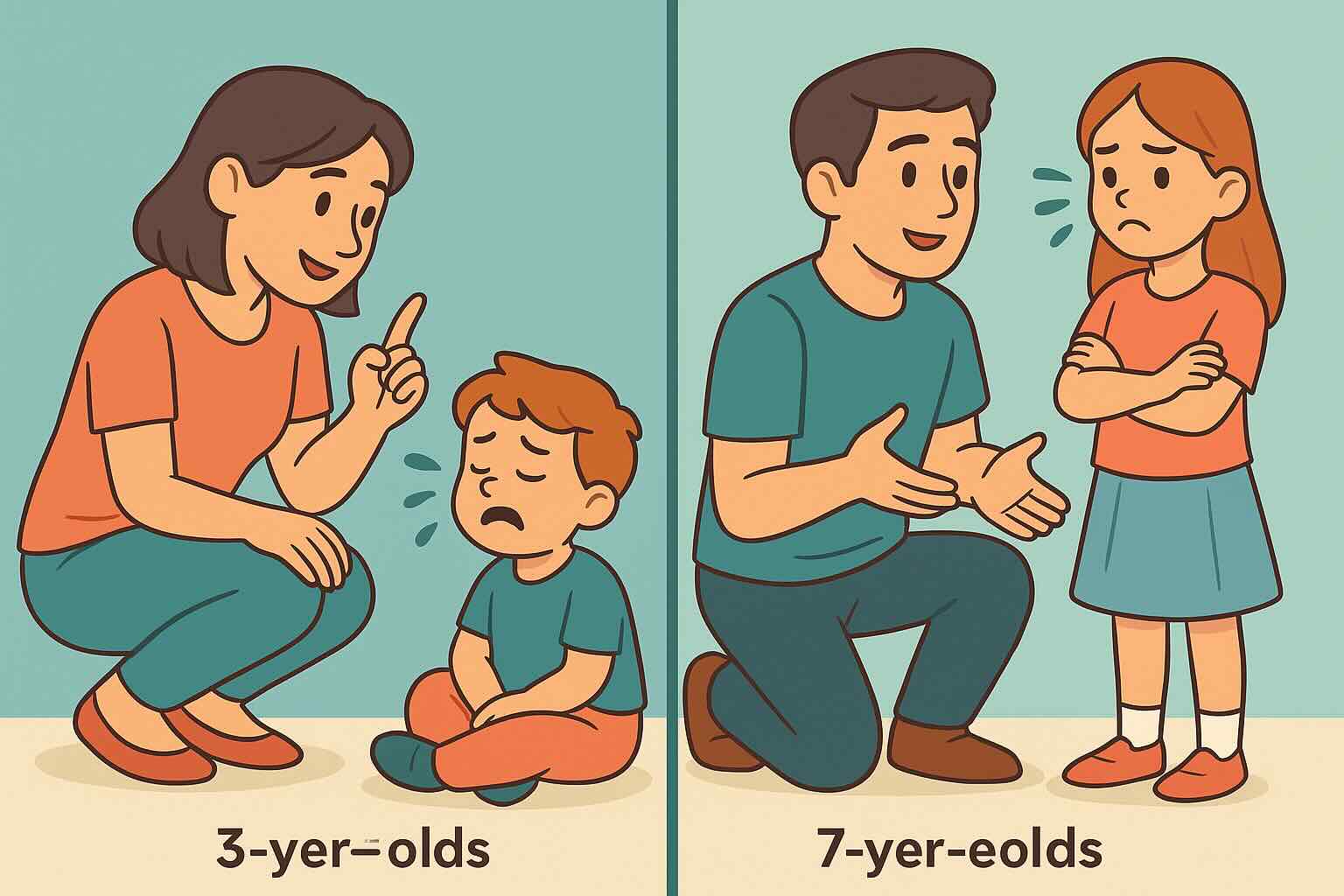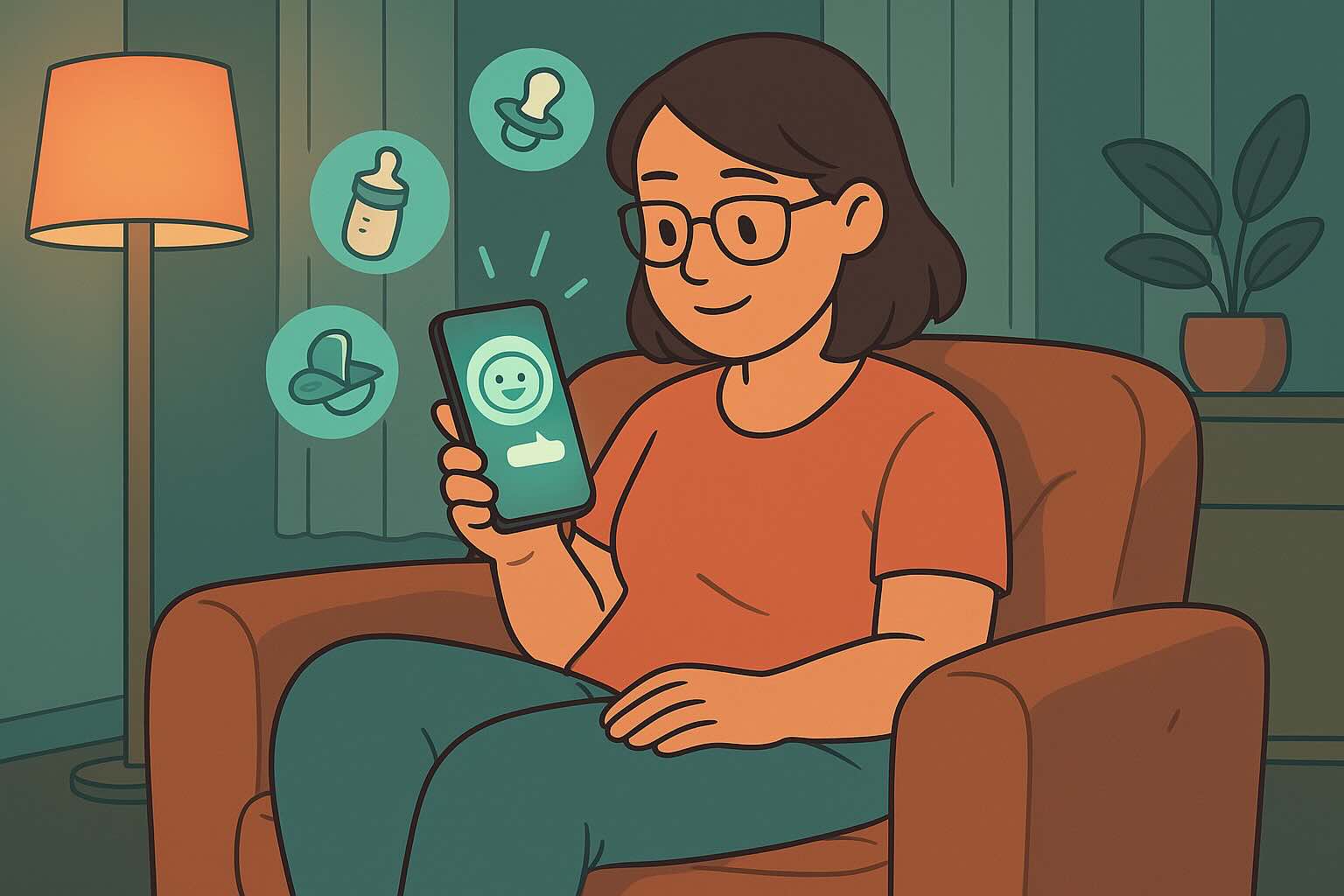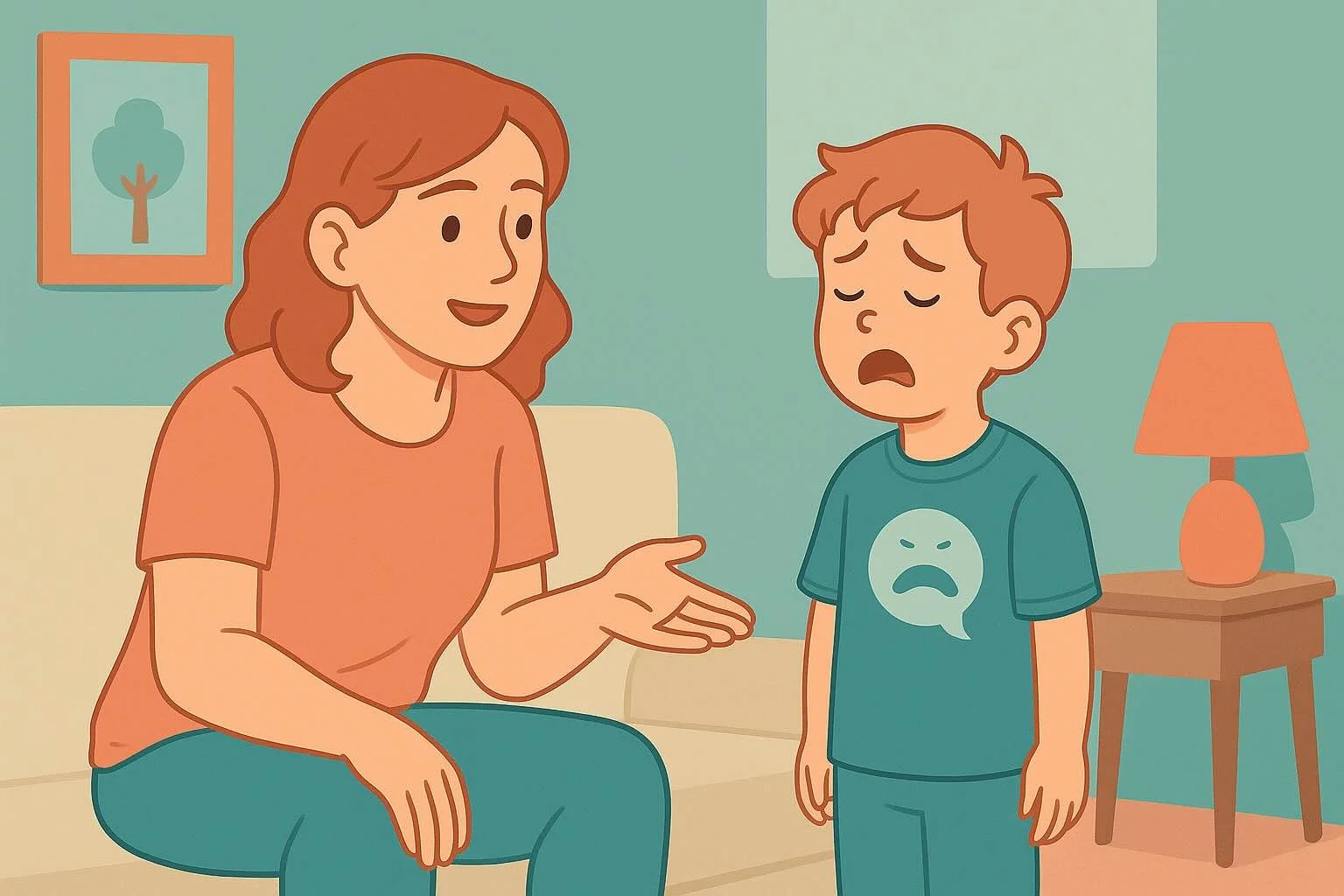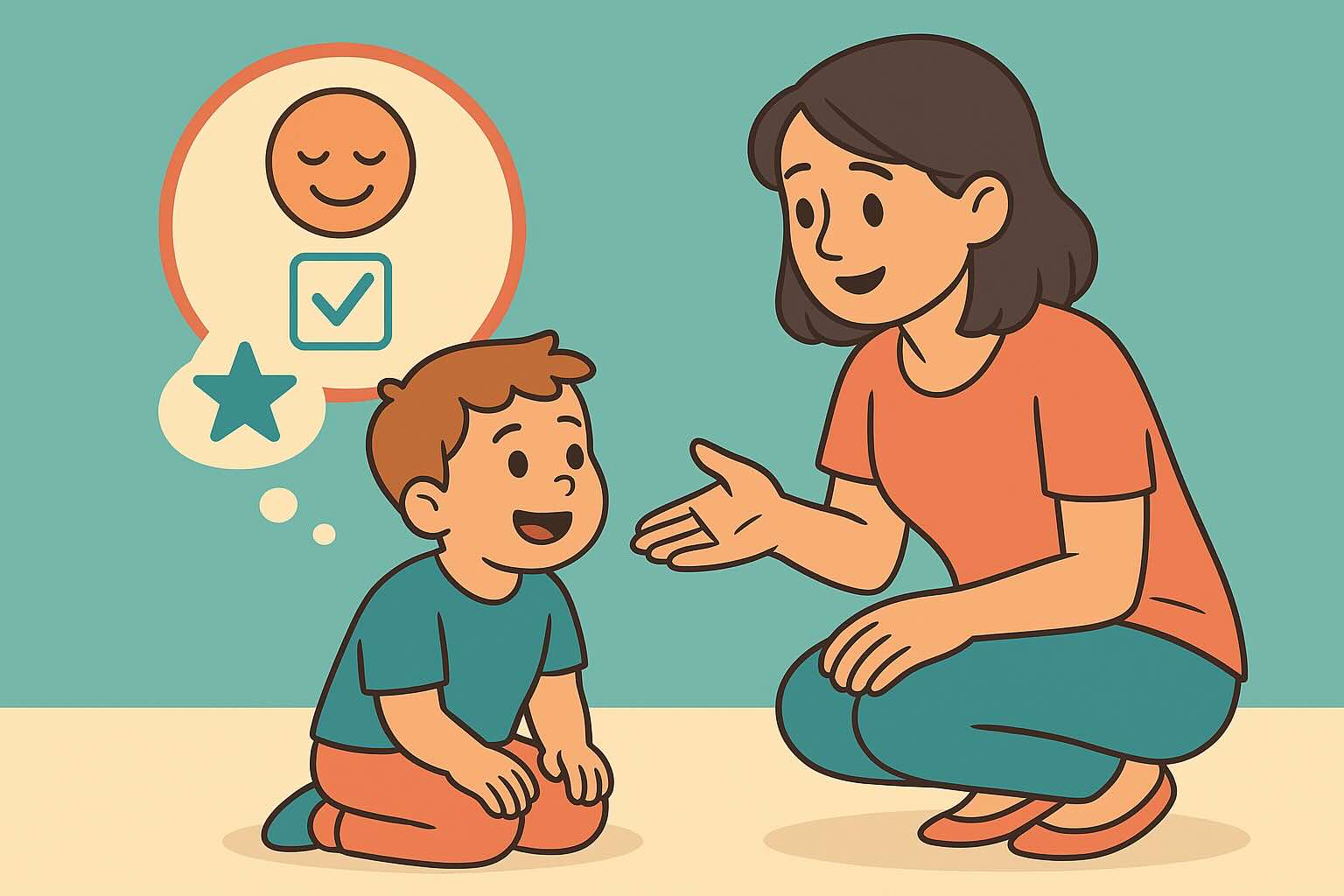Age-Specific Whining Strategies: 10 Techniques That Work for Every Age


"My 6-year-old whines just as much as my 3-year-old—shouldn't she be outgrowing this by now?" If you're wondering why your older child still whines, or why your strategies work for one age but not another, you're asking the right questions. Age makes a huge difference in both why children whine and how they respond to your interventions.
A 3-year-old who whines "I can't do it!" is likely experiencing genuine overwhelm and limited problem-solving skills. A 6-year-old using the same phrase may be testing whether whining will get them help they don't actually need. Same words, completely different motivations—and they require different responses.
This comprehensive guide breaks down whining by developmental stages, giving you targeted strategies that match your child's cognitive, emotional, and social capabilities. For foundational whining strategies, see our complete whining guide, and for prevention techniques, check our whining prevention strategies.
What You'll Learn in This Guide
- Developmental Whining Patterns - How whining changes from ages 3-7 and why
- Ages 3-4: The Foundation Years - Simple, concrete strategies for emerging independence
- Ages 5-7: The Reasoning Years - More sophisticated approaches for developing logic
- Age-Specific Triggers - Different causes of whining at each developmental stage
- Tailored Response Scripts - Exact language that works best for each age group
- Transition Strategies - How to adjust your approach as your child grows
- Common Age-Related Challenges - Typical whining patterns and effective solutions
- Realistic Timeline Expectations - How quickly to expect improvement at each age
Estimated reading time: 13 minutes
Understanding Developmental Whining Patterns
The Whining Evolution: Ages 3-7
Ages 3-4: "I Can't Do It" Whining
- Primary drivers: Limited vocabulary, emotional overwhelm, genuine skill gaps
- Communication style: Simple, repetitive, often includes crying or physical distress
- Duration: Usually shorter bursts (1-3 minutes) but may occur frequently
- Recovery: Faster bounce-back once needs are met or emotions are regulated
Ages 5-7: "This Isn't Fair" Whining
- Primary drivers: Testing boundaries, avoiding challenges, seeking control
- Communication style: More sophisticated arguments, negotiation attempts, strategic timing
- Duration: Can sustain longer whining campaigns (5-15 minutes) with complex reasoning
- Recovery: May hold grudges longer and require more processing time
Brain Development and Whining Capacity
Ages 3-4: Emotional Brain Dominance
- Limbic system (emotions) is very active
- Prefrontal cortex (logic/control) is minimally developed
- Limited ability to think through consequences
- High need for external emotional regulation support
Ages 5-7: Emerging Logic Centers
- Beginning development of cause-and-effect thinking
- Improved language skills for expressing complex ideas
- Still limited impulse control but growing self-awareness
- Can engage in simple problem-solving when calm
Ages 3-4: The Foundation Years
Developmental Characteristics Affecting Whining
Cognitive abilities:
- Vocabulary: 1,000-5,000 words, but limited emotional vocabulary
- Abstract thinking: Very limited—need concrete, immediate concepts
- Memory: Short-term focused, difficulty connecting past experiences to present
- Problem-solving: Basic trial and error, need significant adult support
Emotional characteristics:
- Intensity: Emotions feel overwhelming and all-consuming
- Regulation: Minimal self-soothing skills, high need for co-regulation
- Expression: Physical expressions of emotion (crying, throwing, hitting)
- Recovery: Quick to move on once needs are met
Social awareness:
- Perspective-taking: Very limited ability to see others' viewpoints
- Rule understanding: Concrete rules work better than explanations
- Authority concepts: Beginning to understand "parent is in charge"
Effective Strategies for Ages 3-4
Strategy 1: Simplified Language and Concepts
What to say to 3-4 year olds:
- "Use your big kid voice" (instead of "regular voice")
- "Show me your strong voice"
- "I listen to clear words"
- "Try again with your talking voice"
What NOT to say:
- Long explanations about why whining doesn't work
- Complex reasoning about communication effectiveness
- Abstract concepts about respect or consideration
Example interaction: Child whines: "I want a snaaack"
Ages 3-4 response: "I hear whining. Show me your big kid voice. Say 'snack please.'"
Why this works: Simple, concrete, immediate action they can take.
Strategy 2: Increased Physical Support
3-4 year olds need more:
- Physical presence: Sit or kneel at their level during conversations
- Comfort: Hugs, gentle touch, holding while they regulate emotions
- Visual cues: Show them facial expressions that match "whining" vs. "talking"
- Demonstration: Model the voice you want them to use more explicitly
Physical regulation support:
- Deep breathing together: "Let's smell the flowers" (inhale) "and blow out the candles" (exhale)
- Gentle movement: Swaying, rocking, or walking together
- Sensory comfort: Soft blanket, favorite stuffed animal, quiet space
Strategy 3: Immediate and Simple Consequences
Effective consequences for 3-4 year olds:
- Natural pausing: "When you use your big kid voice, I can help you"
- Simple choices: "You can ask nicely or wait until you're ready"
- Immediate connection: Address the whining right away rather than waiting
- Clear cause-and-effect: "Whining voice means waiting. Talking voice means helping."
Timeline expectations:
- Expect 4-6 weeks for consistent improvement
- Look for shorter whining episodes rather than complete elimination
- Celebrate small wins: using "talking voice" even briefly
- Prepare for regression during illness, big changes, or developmental leaps
Common 3-4 Year Old Whining Scenarios
Scenario 1: "I can't put on my shoes!" Likely reality: Genuinely struggling with fine motor skills
Effective response: "That looks hard. Let me help you get started, then you can finish." Why it works: Acknowledges real difficulty while building independence
Scenario 2: "I don't want to clean up!" Likely reality: Task feels overwhelming, lacks organizational skills
Effective response: "Cleaning up is hard work. Let's do it together. You pick up blocks, I'll pick up books." Why it works: Breaks down overwhelming task, provides support
Scenario 3: "She took my toy!" Likely reality: Limited conflict resolution skills, high emotional reactivity
Effective response: "You're upset about your toy. Use your strong voice to tell her 'That's mine, please give it back.'" Why it works: Teaches specific language for conflict resolution
Ages 5-7: The Reasoning Years
Developmental Characteristics Affecting Whining
Cognitive abilities:
- Vocabulary: 5,000-10,000+ words, developing emotional vocabulary
- Abstract thinking: Beginning to understand concepts like fairness, future consequences
- Memory: Can connect past experiences to present situations
- Problem-solving: Can generate simple solutions with guidance
Emotional characteristics:
- Intensity: Still experience big emotions but with more awareness
- Regulation: Developing self-soothing skills, less need for co-regulation
- Expression: More verbal expression, though may still use physical outlets
- Recovery: May need processing time, can hold onto emotions longer
Social awareness:
- Perspective-taking: Beginning to understand others have different viewpoints
- Rule understanding: Can grasp "why" behind rules and expectations
- Authority concepts: May test authority more strategically
Effective Strategies for Ages 5-7
Strategy 1: Sophisticated Communication Approaches
What to say to 5-7 year olds:
- "I notice you're using a whining voice. What are you trying to tell me?"
- "You have so many clear words. Show me how you can use them."
- "Whining doesn't help me understand what you need."
- "I think you know what to do. Try again, please."
More complex reasoning:
- "When you whine, it's hard for me to want to help because it doesn't sound respectful."
- "What would work better—whining about this problem or thinking of solutions together?"
- "I can see you're frustrated. Let's figure out how to communicate about it."
Example interaction: Child whines: "This homework is too haaard and I don't want to do it!"
Ages 5-7 response: "I hear you're frustrated about homework. That's a hard feeling. What would be a better way to ask for help when something feels difficult?"
For more specific scripts for different types of whining, including dramatic "helpless" whining, see our helpless whining guide.
Strategy 2: Problem-Solving Partnerships
5-7 year olds can engage in:
- Identifying patterns: "I notice you whine most after school. What do you think is happening?"
- Generating solutions: "What are three things we could try when you feel frustrated?"
- Planning ahead: "Tomorrow we have to go grocery shopping. How can we make that work smoothly?"
- Self-reflection: "How did that feel when you used your clear voice instead of whining?"
Collaborative conversations:
- "It seems like whining is your way of telling me you're overwhelmed. What would work better?"
- "I want to help you get what you need. Whining makes it harder for me to understand. What else could you try?"
- "You're smart and capable. I know you can think of a better way to communicate this."
Strategy 3: Higher Expectations with Support
Age-appropriate expectations for 5-7 year olds:
- Self-correction: "I think you know what to do" and waiting for them to adjust
- Multiple chances: "That still sounds like whining. Try again."
- Independence: Less immediate jumping in to help or solve problems
- Consistency: Higher standards maintained across different situations
Support that matches independence:
- Emotional validation while maintaining behavioral expectations
- Teaching self-regulation skills they can use independently
- Problem-solving guidance rather than immediate solutions
- Recognition of their growing capabilities
Common 5-7 Year Old Whining Scenarios
Scenario 1: "My teacher gave me too much homework and it's not fair!" Likely reality: Testing whether whining will get them out of responsibilities
Effective response: "You sound overwhelmed by your homework. Whining about it won't make it go away, but we can make a plan to tackle it. What would be most helpful?" Why it works: Acknowledges feeling while redirecting to problem-solving
Scenario 2: "I never get to do anything fun!" Likely reality: Using dramatic language to test boundaries and gain sympathy
Effective response: "I hear you saying you want more fun activities. Can you think of a better way to ask about that without the dramatic voice?" Why it works: Calls out the drama while staying open to legitimate requests
Scenario 3: "You always say no to everything!" Likely reality: Frustrated by limits, using exaggeration to make their case
Effective response: "That sounds like whining, and it's also not accurate. I say yes to many things. If you want to talk about something specific, use your respectful voice." Why it works: Addresses both the whining and the inaccurate statement
Age-Specific Trigger Differences
Ages 3-4: Basic Needs and Overwhelm Triggers
Most common triggers:
- Physical needs: Hunger, tiredness, overstimulation
- Skill gaps: Tasks genuinely too difficult for development level
- Transitions: Difficulty switching between activities
- Communication gaps: Wanting something but lacking words to express it clearly
- Emotional overwhelm: Big feelings that exceed regulation capacity
Prevention focus for 3-4 year olds:
- Maintain predictable routines for basic needs
- Provide adequate support for genuine skill challenges
- Use more transition warnings and support
- Teach basic emotion words and communication phrases
- Create calm, low-stimulation environments when possible
Ages 5-7: Control and Social Triggers
Most common triggers:
- Autonomy challenges: Feeling controlled or micromanaged
- Academic pressures: School stress, homework, performance anxiety
- Social dynamics: Peer conflicts, friendship challenges, comparison
- Testing phases: Checking whether rules/expectations are firm
- Avoidance strategies: Using whining to escape non-preferred tasks
Prevention focus for 5-7 year olds:
- Provide appropriate choices and decision-making opportunities
- Support school stress and academic challenges proactively
- Address social-emotional learning and friendship skills
- Maintain clear, consistent boundaries while explaining reasoning
- Teach active coping strategies for difficult tasks
Transitioning Between Age-Appropriate Approaches
Signs Your Child is Ready for "Older" Strategies
Moving from 3-4 strategies to 5-7 strategies:
- Child can engage in basic reasoning conversations
- Shows understanding of simple cause-and-effect relationships
- Has vocabulary to express basic emotions and needs
- Demonstrates some self-regulation skills during calm moments
- Responds to brief explanations rather than needing constant repetition
Timeline notes:
- Some children are ready for more sophisticated approaches earlier or later
- Stress, illness, or big changes may require temporary return to simpler strategies
- Development isn't linear—expect back-and-forth between approaches
Gradual Strategy Evolution
Month 1: Assessment and foundation
- Use strategies appropriate for child's current functioning level
- Notice which approaches work best
- Build consistency with chosen approach
Month 2-3: Gentle advancement
- Gradually introduce slightly more sophisticated expectations
- Test child's readiness for increased independence
- Maintain support while raising standards slowly
Month 4+: Age-appropriate mastery
- Expect age-appropriate communication and self-regulation
- Provide guidance for continued growth
- Adjust approach based on individual development and needs
Special Considerations by Age
Ages 3-4: Developmental Red Flags
When to seek additional support:
- Whining continues to escalate after 6-8 weeks of consistent approach
- Child seems unable to use any words when upset (only crying/screaming)
- Significant regression in communication or emotional regulation
- Whining accompanied by concerning behaviors (aggression, self-harm)
- Developmental delays affecting communication or emotional regulation
Ages 5-7: Behavioral Concerns
When to seek additional support:
- Whining increases significantly after starting school
- Child cannot use appropriate communication even when calm
- Whining is accompanied by lying, aggression, or other concerning behaviors
- Academic or social challenges seem to be driving excessive whining
- Family functioning is significantly impacted despite consistent approaches
Age-Specific Success Timelines
Ages 3-4: Patience and Repetition
Week 1-2: Foundation building
- Focus on staying calm and consistent with simple language
- Expect lots of repetition and minimal immediate change
- Celebrate any use of "big kid voice" even briefly
Week 3-4: Pattern recognition
- Child begins to understand "whining voice" vs. "talking voice"
- Some improvement during easiest times of day
- Still expect significant whining during challenging moments
Week 5-8: Gradual improvement
- Noticeable reduction in whining frequency and intensity
- Child occasionally self-corrects without prompting
- More consistent use of appropriate communication
Ages 5-7: Faster Learning with Testing
Week 1-2: Initial resistance
- May increase whining to test whether you're serious about new expectations
- Tries more sophisticated arguments or manipulation strategies
- Important to stay consistent during this testing phase
Week 3-4: Skill building
- Begins using improved communication more regularly
- Still tests boundaries but with awareness of expectations
- Shows pride in using "big kid" communication skills
Week 5-6: Mastery development
- Consistent use of appropriate communication in most situations
- Self-corrects whining without prompting
- Applies skills to new situations independently
Your Age-Appropriate Action Plan
For Ages 3-4: Foundation Building Plan
Daily practices:
- ✅ Use simple, concrete language consistently
- ✅ Provide extra physical comfort and presence
- ✅ Address basic needs proactively (food, rest, stimulation)
- ✅ Practice "big kid voice" during calm moments
- ✅ Offer choices between two acceptable options
Weekly goals:
- ✅ Notice and celebrate any improvement in communication
- ✅ Adjust environment to reduce overstimulation triggers
- ✅ Practice transition warnings and support
- ✅ Build emotional vocabulary through books and conversations
- ✅ Maintain patience with repetition and slow progress
For Ages 5-7: Skill Building Plan
Daily practices:
- ✅ Use more sophisticated language and reasoning
- ✅ Engage in problem-solving conversations
- ✅ Maintain higher expectations with appropriate support
- ✅ Address school and social stressors proactively
- ✅ Teach and practice self-regulation skills
Weekly goals:
- ✅ Collaborate on solutions to recurring challenges
- ✅ Process school and social experiences together
- ✅ Practice communication skills for different situations
- ✅ Encourage independence in problem-solving
- ✅ Connect behavior choices to natural consequences
Key Takeaways: Age-Appropriate Whining Strategies
- ✅ Different ages require different approaches—3-4 year olds need simpler language and more support, 5-7 year olds can handle reasoning and higher expectations
- ✅ Brain development affects whining capacity—younger children have less emotional regulation, older children can use more strategic whining
- ✅ Triggers change with development—3-4 year olds whine from overwhelm, 5-7 year olds whine from control and social issues
- ✅ Recovery timelines vary by age—younger children may take 4-6 weeks, older children often improve in 2-4 weeks
- ✅ Physical support needs decrease with age—3-4 year olds need more comfort, 5-7 year olds need more independence
- ✅ Problem-solving ability increases—older children can participate in finding solutions, younger children need more guidance
- ✅ Expectations should match development—stretch children appropriately without overwhelming them
- ✅ Stress affects age-appropriate functioning—children may temporarily need "younger" strategies during difficult times
- ✅ Individual development varies—some children are ready for advanced strategies earlier or later than peers
- ✅ Consistency remains crucial at all ages—adjust your approach but maintain consistent standards
Remember: Understanding your child's developmental stage helps you choose the most effective strategies while maintaining realistic expectations. Meet them where they are developmentally while gently stretching toward age-appropriate goals.
This approach is based on child development research and age-appropriate expectations. Individual children may vary significantly in their developmental timeline and needs. Consult with professionals if you have concerns about your child's development or if strategies aren't effective after consistent implementation.
24/7 AI Parenting Assistant
Get instant, personalized advice with expert-curated parenting knowledge. Chat with your AI coach anytime, anywhere.

Complete Whining Response Scripts
Calm, effective responses to all types of whining behavior in children ages 3-7.
Frequently Asked Questions
Need personalized support?
RootWise's AI coach can provide tailored strategies for your specific situation, available 24/7 when you need it most.
Learn More About AI Coaching →



